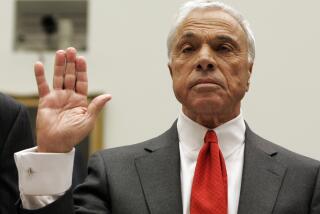Rebuilding an Institution From the Outside In
- Share via
When he took over as Home Savings’ chief executive three years ago, some questioned whether Charles Rinehart, with no savings and loan experience, could successfully guide the old-line mortgage lender through uncertain times.
Before joining Home Savings, the largest thrift in the nation, Rinehart worked at a consumer finance company and had been in the insurance business.
Now analysts and industry observers say his outsider status has been his greatest advantage in quietly, steadily remolding the staid savings and loan into something that looks, feels and acts like a full-service consumer bank.
Rinehart, an ex-Army paratrooper with a mathematics degree, is clearly not bound to tradition, as demonstrated in his boldest move yet: his unsolicited bid late Monday to acquire rival Great Western Financial, the third-largest thrift in the nation.
“He’s really a manager for the 1990s,” said Charlotte Chamberlain, a thrift analyst at Jefferies & Co., a Los Angeles investment firm. “He’s not content with Home being just a preeminent mortgage lender. He wants it to be a preeminent financial institution.”
Home Savings, for example, now originates $60 million a month in consumer loans, up from zero two years ago. It’s a business Rinehart knows well: He was executive vice president of Avco Financial Services before he joined Home Savings in 1989. The thrift has also started offering small-business banking, cash management services and many new consumer loans since Rinehart took over.
Rinehart, a San Francisco native, has installed his own corps of top lieutenants willing to implement his bank-like vision, hiring former First Interstate Bank President Bruce Willison as his second in command. And he has embraced technology as the ticket to success in the 1990s and beyond, installing the thrift industry’s first online banking system.
He made the tough decision to close retail operations totaling 80 branches in New York and Illinois last year. Rinehart also raised the profit bar for the loans that Home Savings keeps in its portfolio, a change that could result in the resale of millions of dollars of loans.
“He’s not a traditional thrift guy, and that has helped him ask some very tough questions about what is the future role of a traditional thrift,” said Bert Ely, president of Ely & Co., an Alexandria, Va.-based consulting firm. “You have to be a tough customer. He’s obviously taking some bold moves and recognizing certain realities.”
The shift in direction has claimed some casualties along the way. Home Savings President Fredric Forster resigned in April after reportedly resisting some of Rinehart’s ideas on redirecting the thrift.
Physically imposing but soft-spoken and bookish in conversation, Rinehart, 50, had big shoes to fill when he took the reins from longtime Home Savings leader Richard H. Deihl in November 1993. (Rinehart replaced Deihl in 1995 as chairman of H.F. Ahmanson, Home Savings’ parent firm.)
Deihl saved his thrift from becoming a casualty of the S&L; debacle in the 1980s by sticking to the industry’s traditional business of making mortgage loans at a time when other thrifts made disastrous forays into real estate development and other money-losing ventures. Those misguided efforts cost the federal government billions of dollars in bailouts.
Predicting rising interest rates and higher inflation, Deihl’s Home Savings made no fixed-rate mortgage loans from 1974 to 1988, popularizing variable rate mortgages.
Rinehart, like his mentor Deihl, is described as a “big picture” leader. Deihl recruited Rinehart from Avco as his heir apparent.
“Charlie is proving himself to be among the best and the brightest among the financial services managers,” said analyst Chamberlain. She added that the merger offer was a bold way of leveraging Ahmanson’s high stock price, which has risen much faster than Great Western stock in the last several weeks.
More to Read
Inside the business of entertainment
The Wide Shot brings you news, analysis and insights on everything from streaming wars to production — and what it all means for the future.
You may occasionally receive promotional content from the Los Angeles Times.










